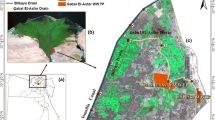Abstract
Oil spill detection and subsequent monitoring are of major concern for coastal zone management as they form potential marine pollutants. The present study is based on examining the feasibility of Moderate Resolution Imaging Spectroradiometer (MODIS) high resolution bands (250 and 500 m) for detection of oil spill. The MODIS — Aqua for 18, 19 and 20th January 2003 were used to study the oil spill in Lake Maracaibo, Venezuela. The examination of L1B and L2 data revealed that L2 products such as SST, Rrs and BRDF were not very useful due to erroneous atmospheric corrections. Visual examination of raw radiance data i.e. L1B data in the 250 and 500 m spatial resolution was found to be the simplest yet feasible method for spill detection. The study further revealed that atmospherically uncorrected radiances at 469, 555 and 645 nm were showing significant signature of oil spill. Therefore an attempt was made to perform ratio operations to enhance the feature. The study concluded that the ratio of difference and sum at 645 and 555 nm, normalized by 469 nm, provides the best result. The result was validated by comparing with the previous published literature. The result clearly indicates the potential of MODIS-Aqua high resolution data in oil spill monitoring. Therefore, MODIS-Aqua data with daily coverage and high resolution can be reliable and cost-effective for such events.
Similar content being viewed by others
References
Chust G and Sagarminanga Y (2007) The multi-angle view of MISR detects oil slicks under sun glitter conditions. Remote Sensing of Environment 107: 232–239
Esaias E, Abbott M and Barton I (1998) An overview of MODIS capabilities for ocean science observations. IEEE Trans Geosci Remote Sensing 36(4): 1250–1265
Fingas Merv F and Brown C (1997) Remote Sensing of Oil Spills. Sea Technology 38: 37–46
Fingas Merv F and Brown C (2000) Oil-spill remote sensing-An update, Sea Technology 41: 21–26
Hu C, Muller-Karger FE, Tayler C, Myhre D, Murch B, Odriozola AL and Godoy G (2003). MODIS detects oil spills in lake Maracaibo, Venezuela., ESO Transactions — American Geophysical Union 84(33): 313–319.
Liu AKS, Tseng YWY and Pichel WG (2000) Wavelet analysis of SAR images for coastal monitoring. Can J Rem 26, 494–500
Richard JS and Richard A Geyer (1992) ”Fates and Effects of Oil Spills”, in Jack M. Hollander (Ed.), Annual Review of Energy and the Environment, Annual Review Inc.
Author information
Authors and Affiliations
Corresponding author
About this article
Cite this article
Srivastava, H., Singh, T.P. Assessment and development of algorithms to detection of oil spills using MODIS data. J Indian Soc Remote Sens 38, 161–167 (2010). https://doi.org/10.1007/s12524-010-0007-9
Received:
Accepted:
Published:
Issue Date:
DOI: https://doi.org/10.1007/s12524-010-0007-9




